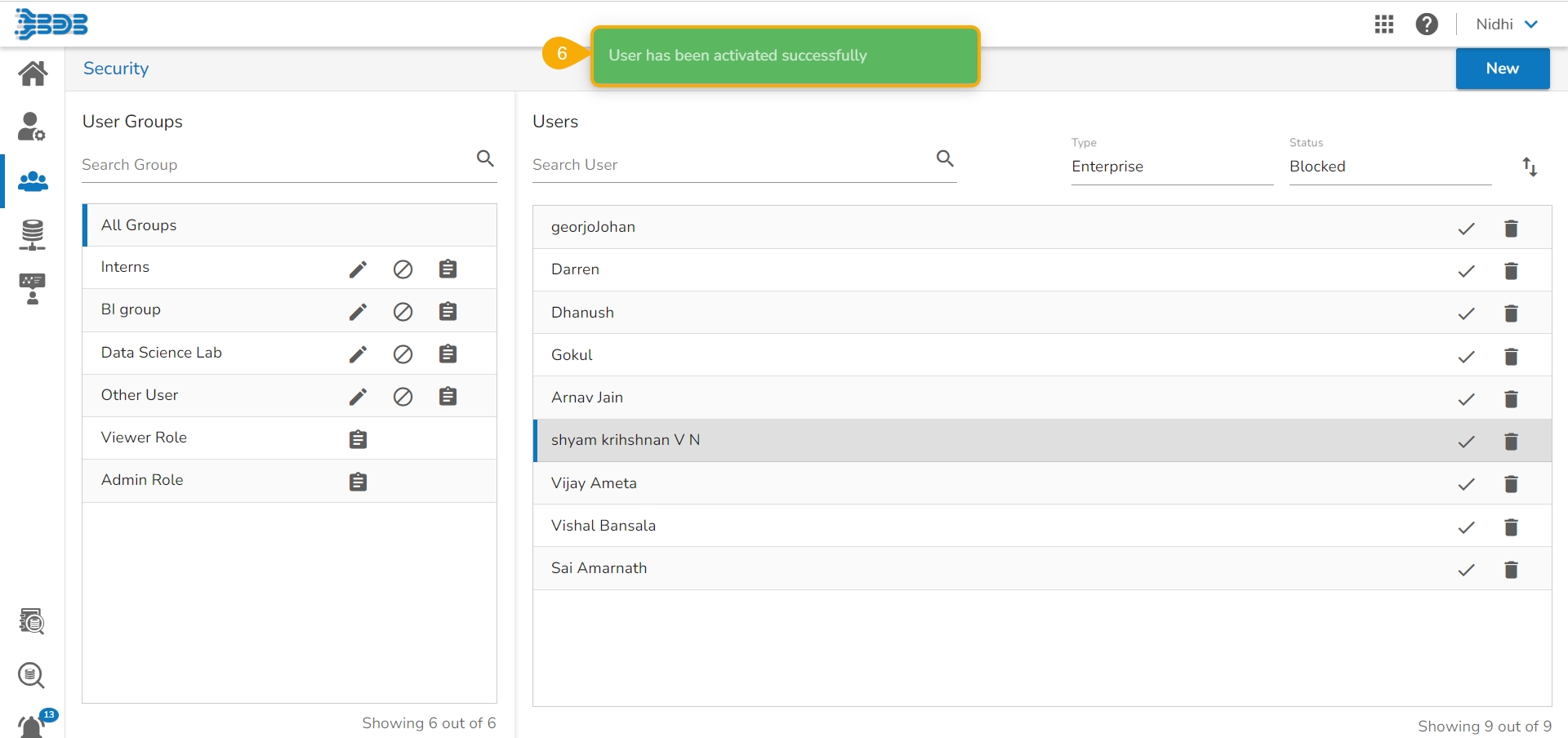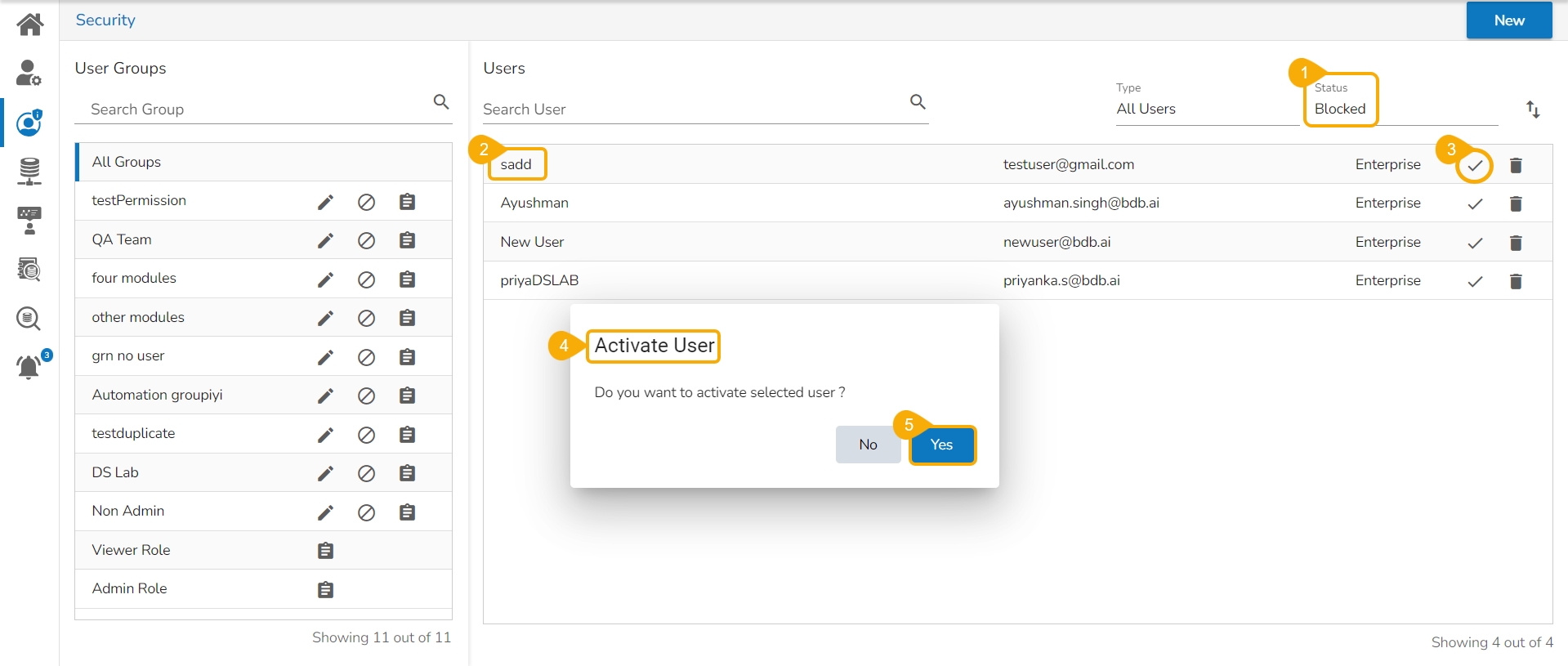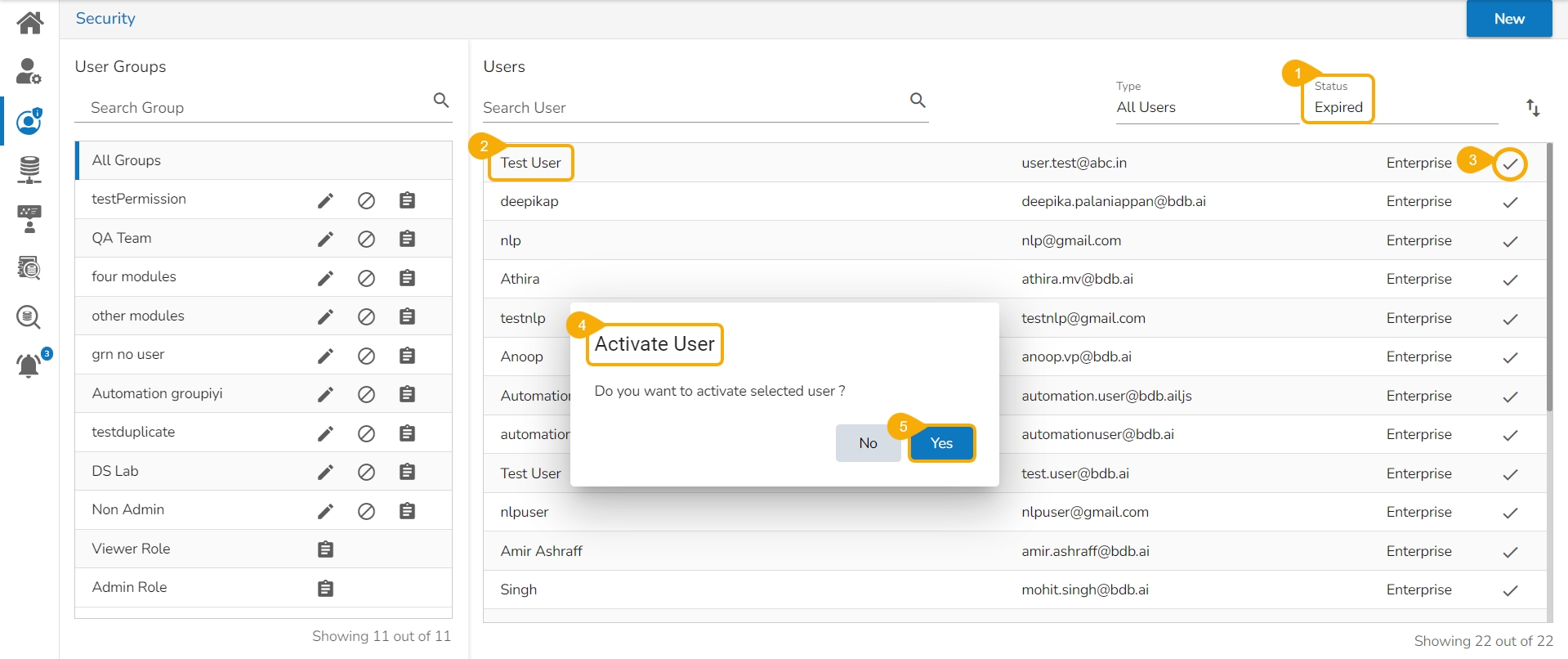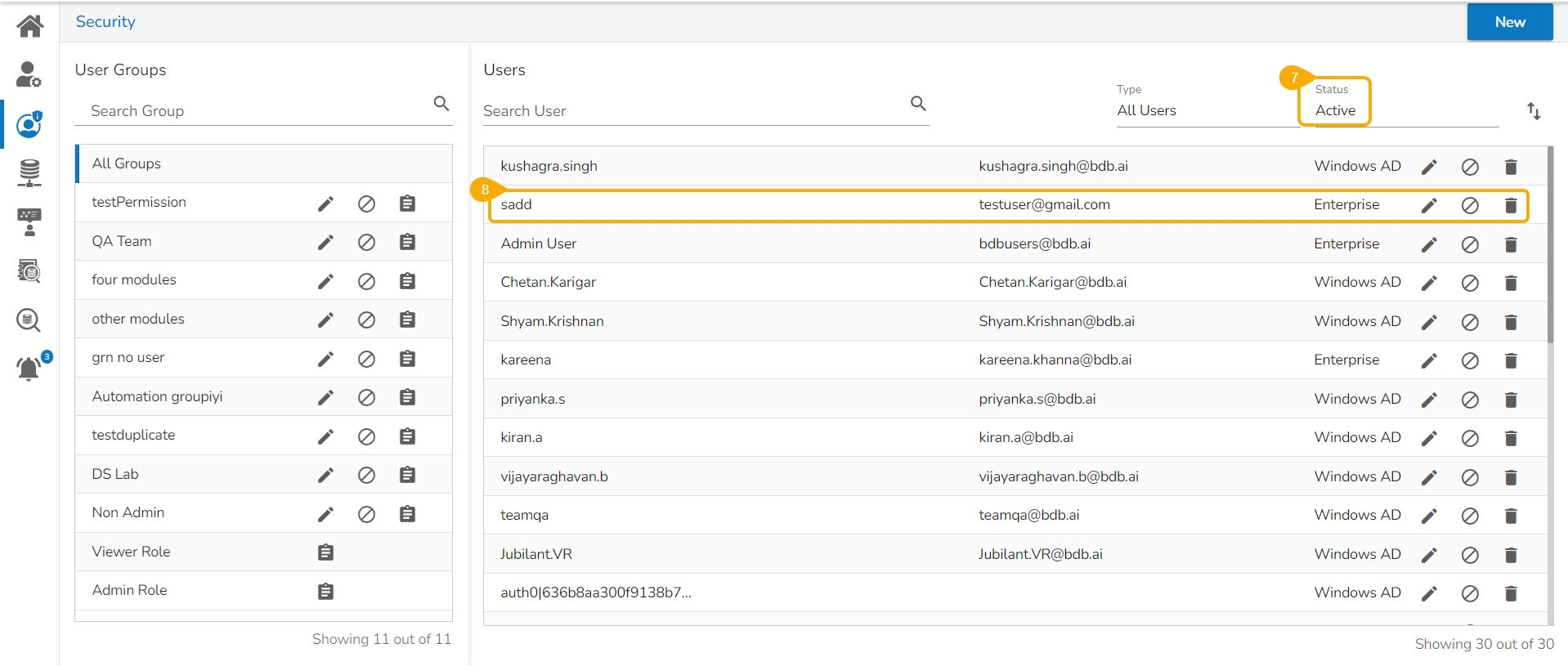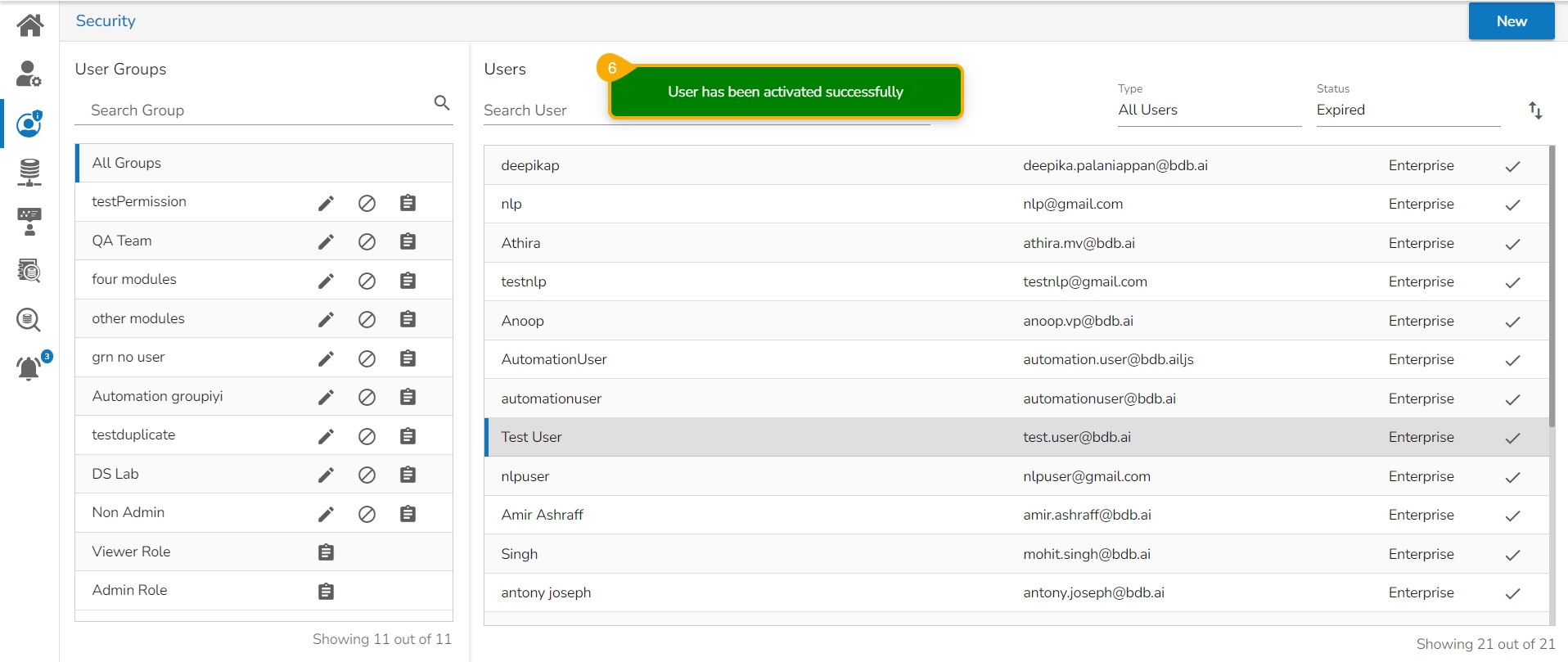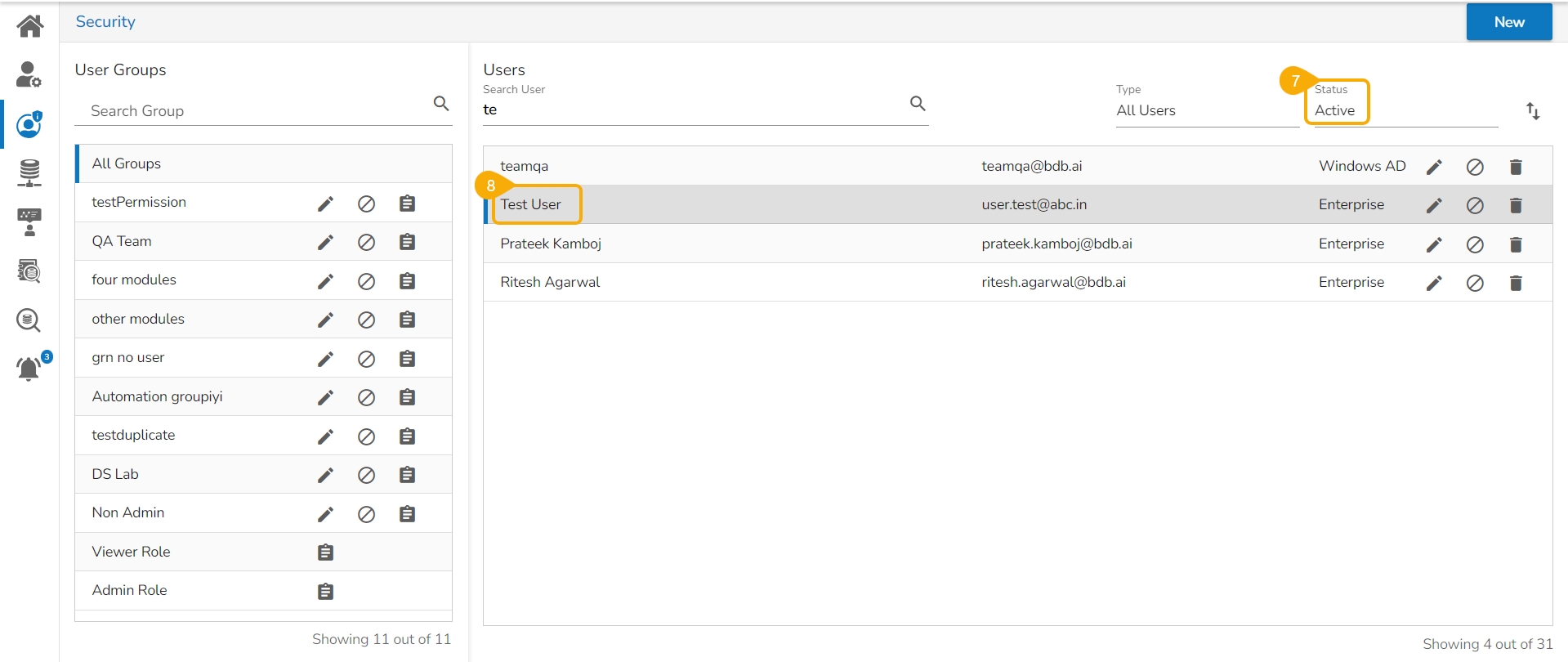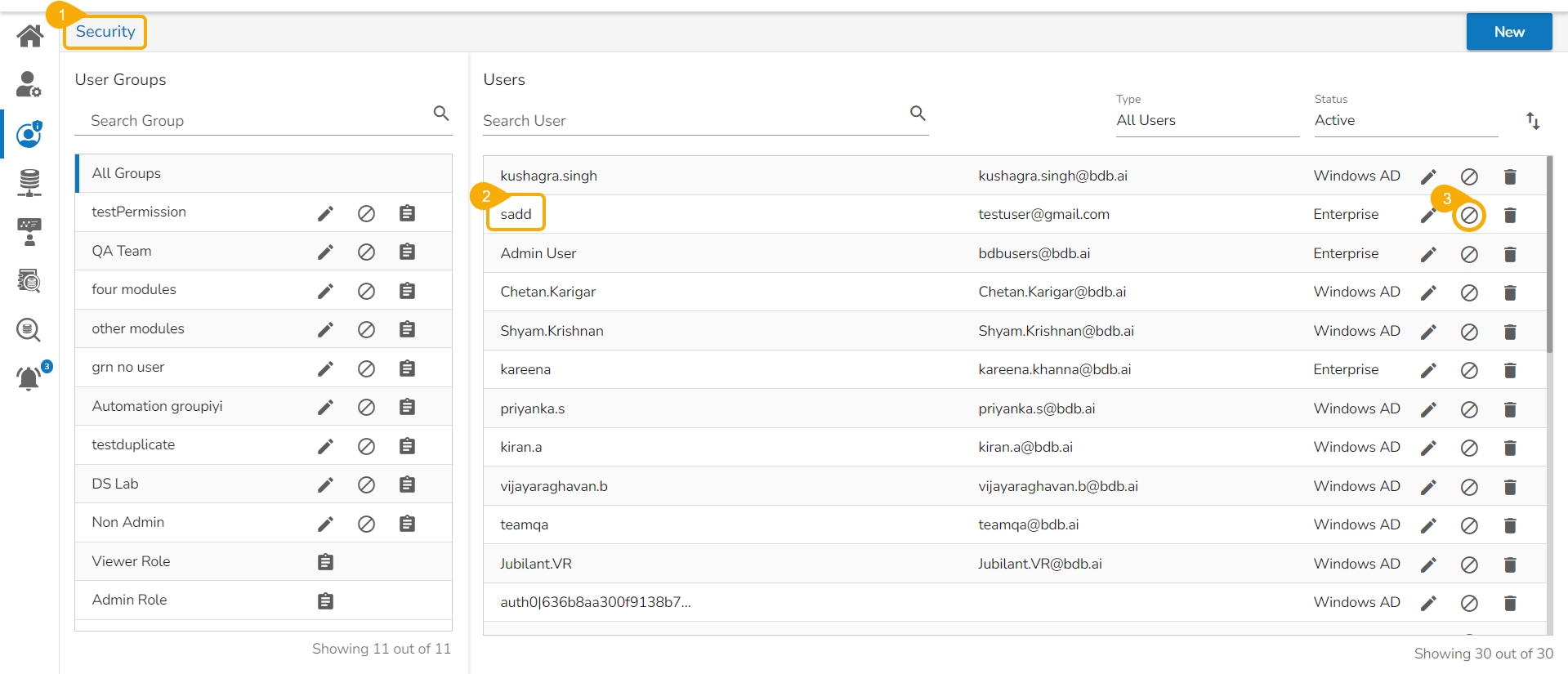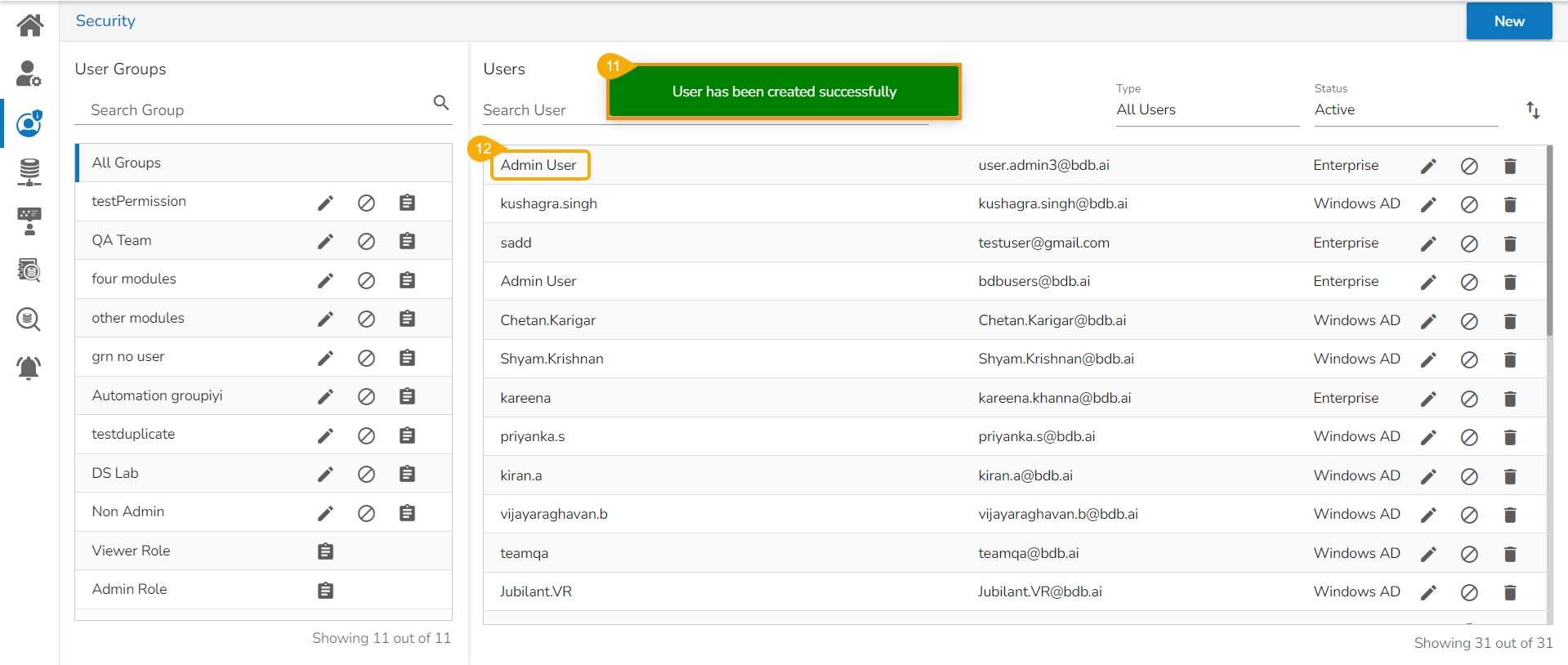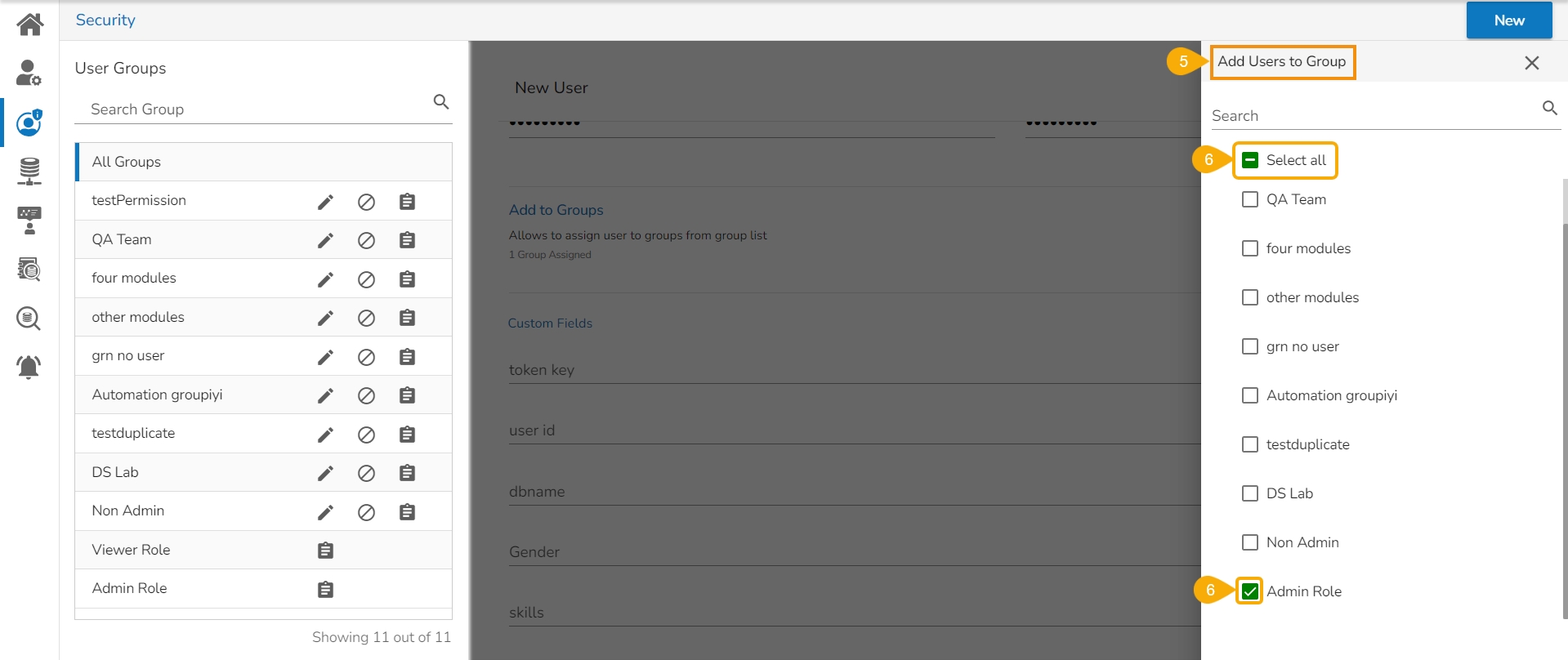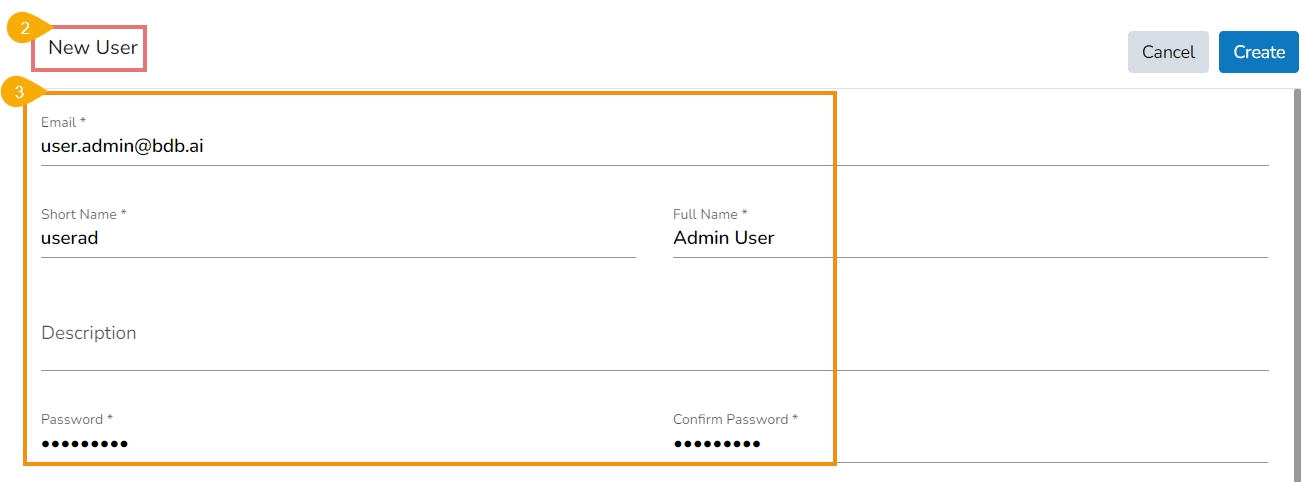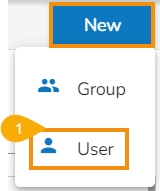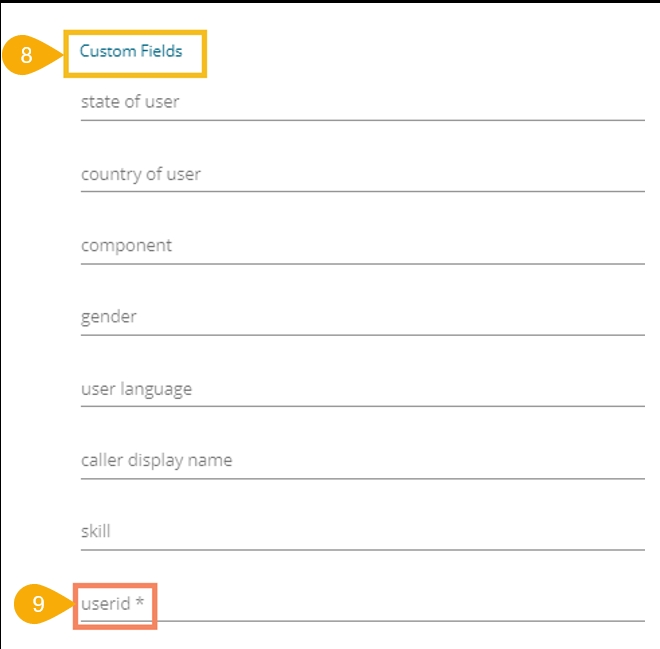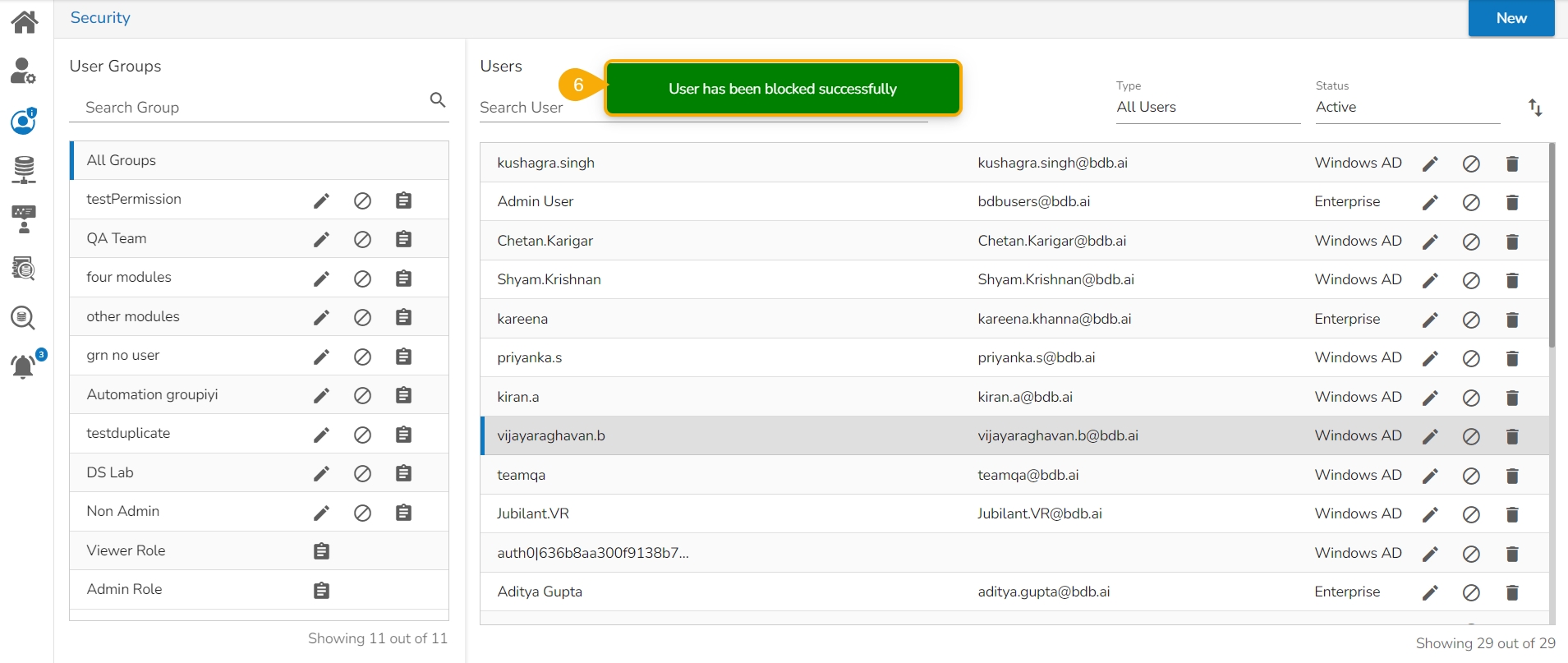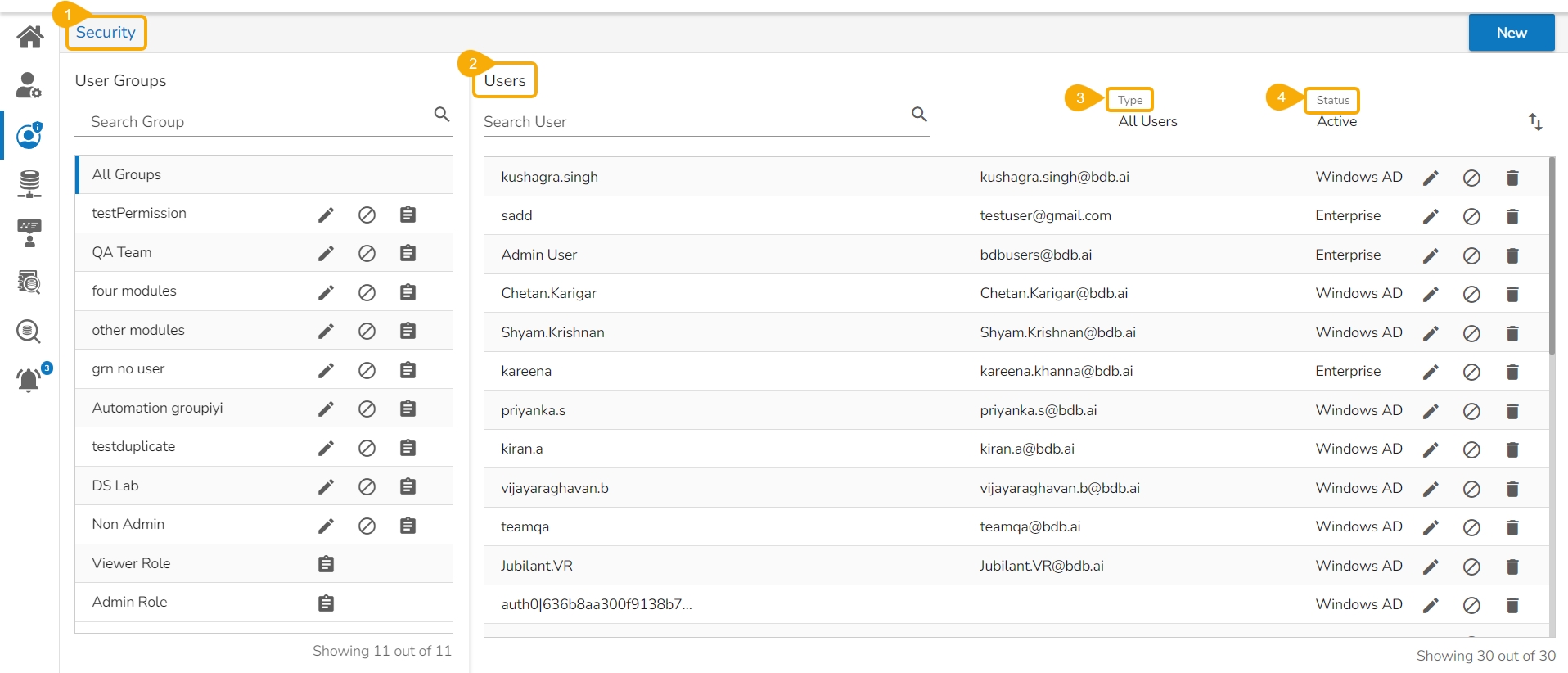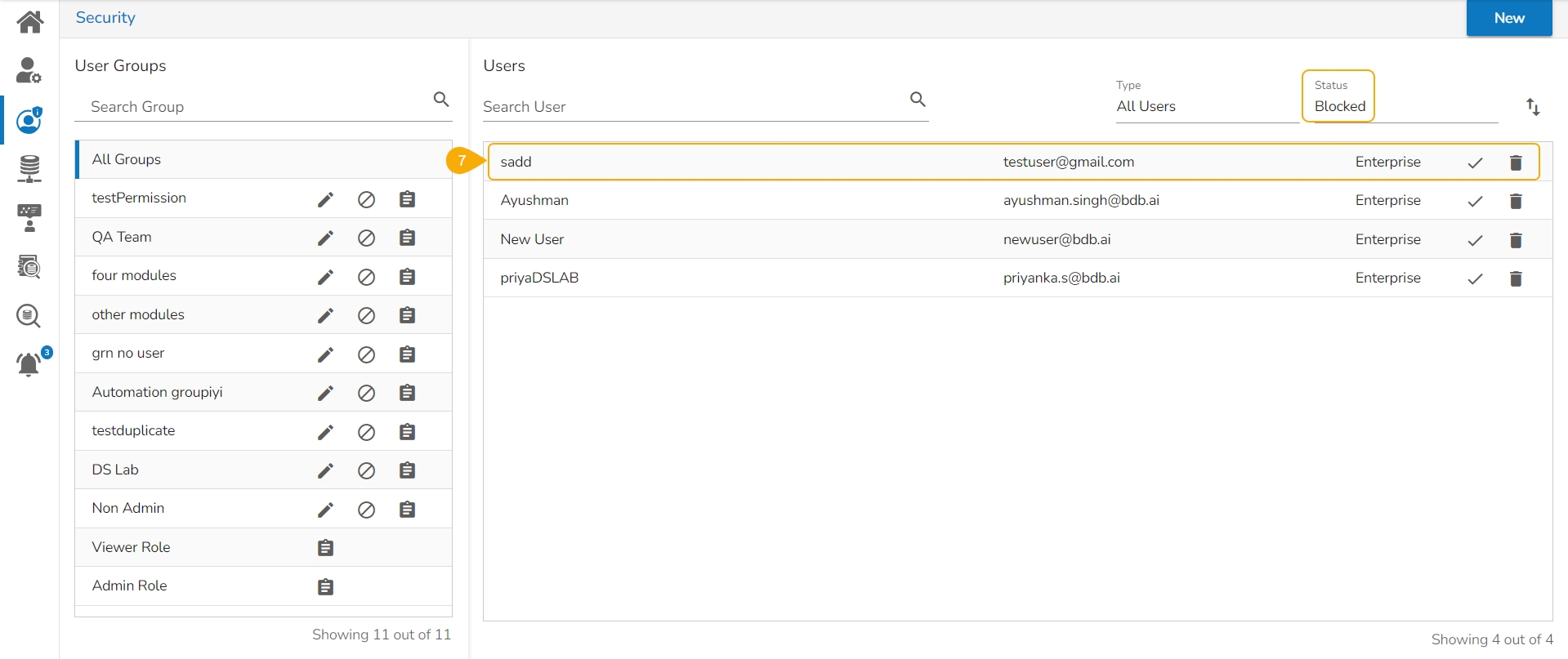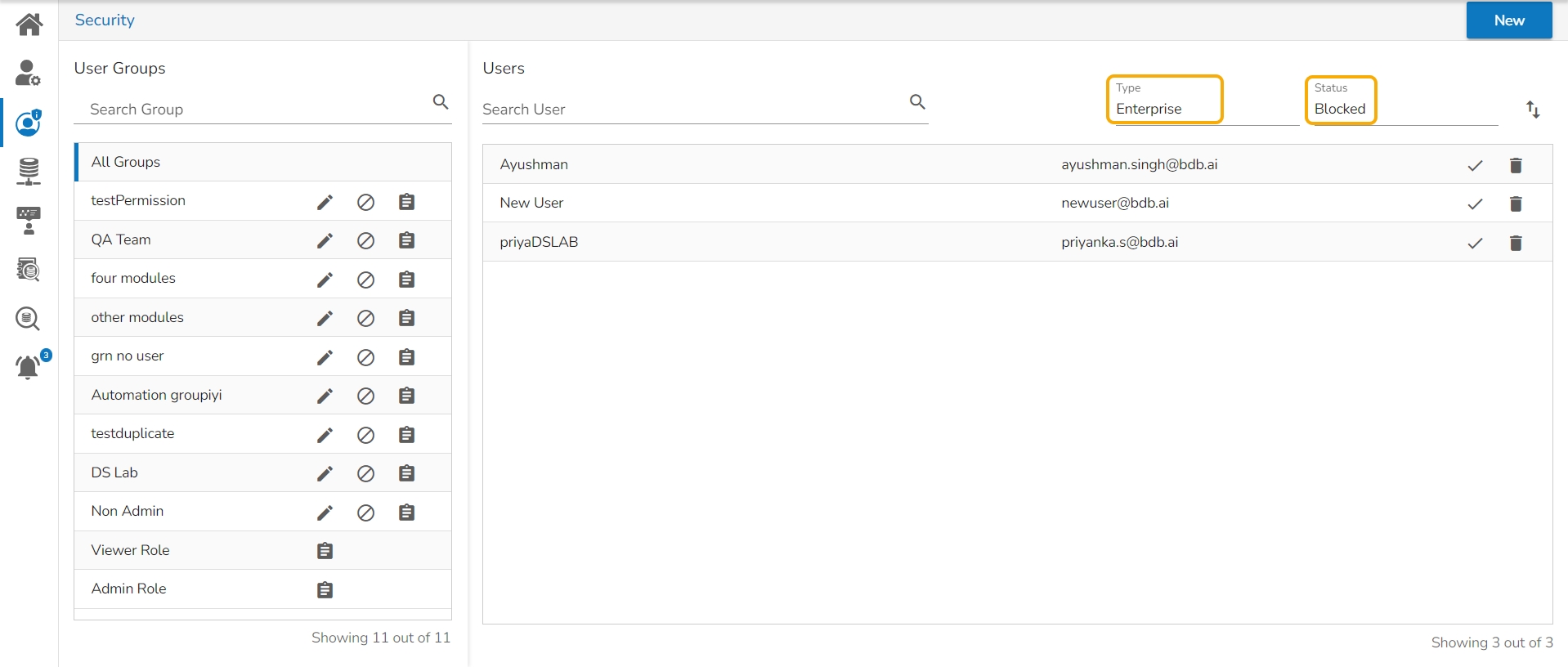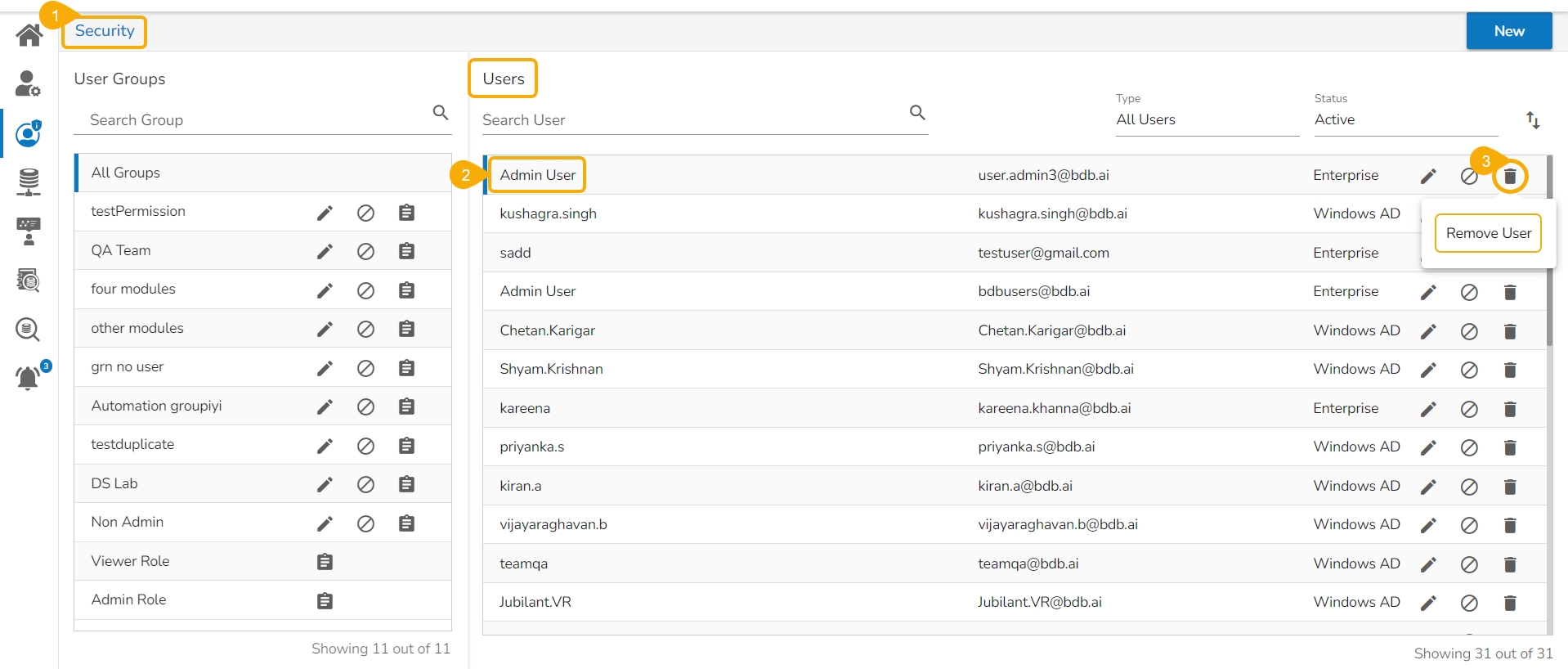
Loading...
Loading...
Loading...
Loading...
Loading...
Loading...
Loading...
Navigate to the Security page.
Select a user from the Users list. (By default, the Users list displays All Users type listing Active users)
Click the Block User icon for the selected user.
The Block User dialog box appears to confirm the deletion.
Click the Yes option.
A notification message appears, and the selected user gets removed from the Active Users list.
The selected user gets added to the Blocked Users list.
Please Note: A user may also get blocked for consecutively using the wrong password more than 3 times or the permitted limit set by the administrator.
This feature helps the administrator to identify the various types of platform users and enable an expired user account.
Navigate to the User Security page.
You can see two drop-down menus.
Type: It contains the following authentication types as drop-down options.
Enterprise
Window AD
CA PPM
AWS Cognito
Status: It includes the following user status as drop-down options
Active
Blocked
Expired
Deleted
Please Note: The Users list displays All Users with Active status by default while accessing the User Security page.
You can select any combination of the filter values mentioned above to display filtered/customized lists of users. E.g., The given image displays a filtered user list with all the Enterprise users with Blocked Status.
This section explains the steps to Activate a user from the Blocked or Expired Users lists.
Select Blocked as the status option to generate the users list with blocked users.
Select a user from the list of all blocked users list.
Click the Activate User icon to activate a specific user.
The Activate User dialog box appears to confirm the action.
Click the Yes option.
A notification message appears and the selected user gets activated.
Navigate to the Active user page by selecting the Status option.
The newly activated user gets listed here.
Select Expired as the status option.
Select a user from the list of all expired user accounts/ groups that appear.
Click the Activate User icon to activate a specific user.
The Activate User dialog box appears to confirm the action.
Click the Yes option.
A notification message appears.
Navigate to the Active user page by selecting the Status option.
The newly activated user gets listed here.
This section describes steps to create new user.
Select the User option from the New Context menu.
The New User form opens.
Fill in the following information to create a new User:
Email: Provide an email address to be registered for the user.
Short Name: Short name of the user.
Full Name: Full name of the user.
Description: Describe the user (optional).
Password: Set password for the new user.
Confirm Password: Confirm the above password.
Click the Assign option to add the new User to Group(s).
The Add Users to Group window opens, listing all the groups.
Either choose the Select all option or select the specific group(s) using the checkmarks.
The selected group(s) will be assigned, and the number of the selected groups will mentioned.
Pre-configured custom fields are displayed under the Custom Fields heading in this form.
The users can provide the required details using the custom fields if marked as mandatory (A user gets group-specific custom fields).
Click the Create option.
A confirmation message appears.
The newly created user gets added to the user list.
Please Note:
All the user-specific details other than email ID can be updated/edited by the Update User option.
If the new user gets added to a Group with all the permission access, the new user will get the Admin Role.
A single user can be a part of multiple groups, and the user can get collective permissions from all the groups to access different platform modules.
Platform admin can restrict the data access for the non-admin users using the Custom Fields.
Pre-requisites:
The user must be able to access the dataset or data store to which the data access restriction is applied.
The necessary must be configured to the user account.
Check out the illustration on restricting data access of a Dataset for a user.
Navigate to the Data Center module using an Admin user account.
Click the Data Sets icon.
The Data Sets list page opens.
Select a dataset from the list.
Click the View/ Edit icon for the selected Data Set.
The Data Set update page opens for the selected data set.
Click the Validate option.
Please Note: The Validate option will be available only for the database-based data sets. The other types of Data Sets will contain the Preview Data option to display the data preview.
A notification message appears and the table gets updated.
The data preview is displayed under the Preview Result section.
Click the Security module icon.
The Users list opens under the Security module.
Select a user from the list.
Click the Edit icon.
The Update User page opens.
Navigate to the Custom Fields section and configure the mandatory custom field.
Specify the required custom field value using the user look-up option.
Click the Save option.
Please Note: If the configured option for the Custom Fields is Manual, then the admin user must provide a username manually to restrict the data, instead of selecting a user from the user lookup list.
Sign in to a non-admin user platform account.
Click the Data Center icon.
Navigate to the Data Sets list page.
Select the same data set that was selected under the Admin user.
Click the Edit icon for the selected data set.
A notification message appears and the table gets updated.
Click the Validate option.
The restricted data preview appears under the Preview Result section.
Check out the illustration on restricting data access of a Data Store for a user.
Navigate to the Data Center module using an Admin user account.
Click the Data Stores icon.
The Data Stores list opens.
Select a data store from the displayed list.
Click the Edit icon for the selected data store.
The Data Store update page opens displaying the Getting Data tab for the selected data store.
Please Note: Click the Next option to navigate to the other tabs involved in the Data Store creation.
Open the Data Restrictions tab.
Select a dimension using the Dimension drop-down menu.
Configure the User Property. Use the same as the selected Dimension.
Click the Next option.
Navigate to the Schedule Data Refresh tab to finish the Data Store update.
A notification message ensures that the Data Store has been updated successfully.
Navigate to the platform Homepage.
Click the Report icon to start a new report. OR Open an existing report from the platform homepage.
Navigate to the Design page of the report.
Create a view using dimension and measure. The created View displays data for all the names.
Open the Security module.
The Users section lists all the existing users.
Use the Search bar to search for a specific user from the list.
Select a user from the list.
Click the Edit icon for the selected user.
The Update User page appears for the selected user.
Provide a user name using the Custom Fields fields. E.g., Anagha is mentioned in the given image for the Name custom field.
Click the Save option.
Please Note: If the Custom Fields option is set to Manual, the admin must manually enter a username to restrict the data, rather than choosing one from the user lookup list.
Sign in to a non-admin user account.
Click the Data Center icon.
Navigate to the Data Stores list page.
Select the data store where you want to restrict data.
Click the Edit icon for the selected data store.
Navigate to the Data Restrictions tab for the selected Data Store.
Select a Dimension using the drop-down menu.
Configure the User Property for the selected dimension. It should be the same as the chosen dimension.
Click the Next option to move to the next tab. The user will be redirected to the Schedule Refresh tab to finish the data store update process.
Click the Report icon to create a new report (You may use an existing report and select the recently updated data store to create a view). Click the Select Existing Data Store option to create the report based on the updated data store.
Select the same data store where you have configured the Data Restrictions tab.
Click the Create Report option.
The Design page appears for the report. Select Dimension and Measure to create a View.
A View appears with the limited data. E.g., only Angha's data will be listed for this user since it was configured for the same user using the Custom Fields for the user.
This functionality is available only for the Enterprise users.
Open the Security page.
Navigate to the Users list.
User the Search Bar to search for a specific user.
Select the Enterprise option using the Type filter.
Select the Active option for the Status filter.
Select a user from the Users list.
Click the Reset Password icon.
A notification message ensures the password reset link has been sent to the registered mail.
The user will receive the Reset Password link on the registered email from the support team. Click the Reset Password link.
The user will be redirected to the Reset Password page.
Provide a new password.
Confirm the new password.
Click the Continue option
The password will be reset for the selected user account.
This option helps to remove a user from the user list.
Navigate to the Security page.
Select a user from the Users list.
Click the Remove User icon for the selected user.
The Remove User dialog box appears to confirm the deletion.
Click the Yes option.
A notification message appears.
The selected user gets removed from the Users list.
Please Note: You can configure the Custom Fields part using the option Admin module The list of mandatory Custom Fields for a user helps to Restrict the Data Access for that user.































